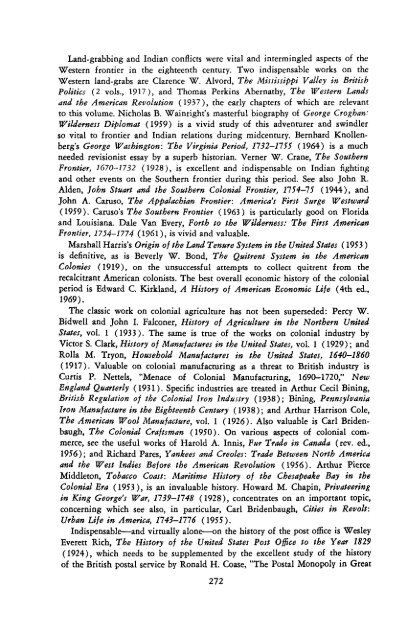Conceived in Liberty Volume 2 - Ludwig von Mises Institute
Conceived in Liberty Volume 2 - Ludwig von Mises Institute
Conceived in Liberty Volume 2 - Ludwig von Mises Institute
You also want an ePaper? Increase the reach of your titles
YUMPU automatically turns print PDFs into web optimized ePapers that Google loves.
Land-grabb<strong>in</strong>g and Indian conflicts were vital and <strong>in</strong>term<strong>in</strong>gled aspects of the<br />
Western frontier <strong>in</strong> the eighteenth century. Two <strong>in</strong>dispensable works on the<br />
Western land-grabs are Clarence W. Alvord, The Mississippi Valley <strong>in</strong> British<br />
Politics (2 vols., 1917), and Thomas Perk<strong>in</strong>s Abernathy, The Western Lands<br />
and the American Revolution (1937), the early chapters of which are relevant<br />
to this volume. Nicholas B. Wa<strong>in</strong>right's masterful biography of George Croghan`<br />
Wilderness Diplomat (1959) is a vivid study of this adventurer and sw<strong>in</strong>dler<br />
so vital to frontier and Indian relations dur<strong>in</strong>g midcentury. Bernhard Knollenberg's<br />
George Wash<strong>in</strong>gton: The Virg<strong>in</strong>ia Period, 1132-115S (1964) is a much<br />
needed revisionist essay by a superb historian. Verner W. Crane, The Southern<br />
Frontier, 1670-1732 (1928), is excellent and <strong>in</strong>dispensable on Indian fight<strong>in</strong>g<br />
and other events on the Southern frontier dur<strong>in</strong>g this period. See also John R.<br />
Alden, John Stuart and the Southern Colonial Frontier, 1154-1! (1944), and<br />
John A. Caruso, The Appalachian Frontier: America's First Surge Westward<br />
(1959). Caruso's The Southern Frontier (1963) is particularly good on Florida<br />
and Louisiana. Dale Van Every, Forth to the Wilderness: The First American<br />
Frontier, 1754-1774 (1961), is vivid and valuable.<br />
Marshall Harris's Orig<strong>in</strong> of the Land Tenure System <strong>in</strong> the United States (1953)<br />
is def<strong>in</strong>itive, as is Beverly W. Bond, The Quitrent System <strong>in</strong> the American<br />
Colonies (1919), on the unsuccessful attempts to collect quitrent from the<br />
recalcitrant American colonists. The best overall economic history of the colonial<br />
period is Edward C. Kirkland, A History of American Economic Life (4th ed.,<br />
1969).<br />
The classic work on colonial agriculture has not been superseded: Percy W.<br />
Bidwell and John I. Falconer, History of Agriculture <strong>in</strong> the Northern United<br />
States, vol. 1 (1933). The same is true of the works on colonial <strong>in</strong>dustry by<br />
Victor S. Clark, History of Manufactures <strong>in</strong> the United States, vol. 1 (1929); and<br />
Rolla M. Tryon, Household Manufactures <strong>in</strong> the United States, 1640-1860<br />
(1917). Valuable on colonial manufactur<strong>in</strong>g as a threat to British <strong>in</strong>dustry is<br />
Curtis P. Nettels, "Menace of Colonial Manufactur<strong>in</strong>g, 1690-1720," New<br />
England Quarterly (1931). Specific <strong>in</strong>dustries are treated <strong>in</strong> Arthur Cecil B<strong>in</strong><strong>in</strong>g,<br />
British Regulation of the Colonial Iron Industry (1938); B<strong>in</strong><strong>in</strong>g, Pennsylvania<br />
Iron Manufacture <strong>in</strong> the Eighteenth Century (1938); and Arthur Harrison Cole,<br />
The American Wool Manufacture, vol. 1 (1926"). Also valuable is Carl Bridenbaugh,<br />
The Colonial Craftsman (1950). On various aspects of colonial commerce,<br />
see the useful works of Harold A. Innis, Fur Trade <strong>in</strong> Canada (rev. ed.,<br />
1956); and Richard Pares, Yankees and Creoles: Trade Between North America<br />
and the West Indies Before the American Revolution (1956). Arthur Pierce<br />
Middleton, Tobacco Coast: Maritime History of the Chesapeake Bay <strong>in</strong> the<br />
Colonial Era (1953), is an <strong>in</strong>valuable history. Howard M. Chap<strong>in</strong>, Privateer<strong>in</strong>g<br />
<strong>in</strong> K<strong>in</strong>g George's War, 1139-1148 (1928), concentrates on an important topic,<br />
concern<strong>in</strong>g which see also, <strong>in</strong> particular, Carl Bridenbaugh, Cities <strong>in</strong> Revolt:<br />
Urban Life <strong>in</strong> America, 1143-1116 (1955).<br />
Indispensable—and virtually alone—on the history of the post office is Wesley<br />
Everett Rich, The History of the United States Post Office to the Year 1829<br />
(1924), which needs to be supplemented by the excellent study of the history<br />
of the British postal service by Ronald H. Coase, "The Postal Monopoly <strong>in</strong> Great<br />
272
















